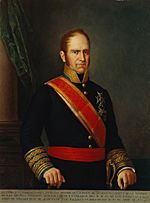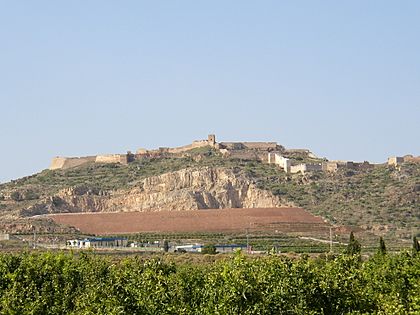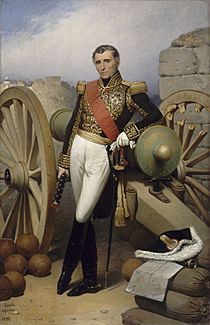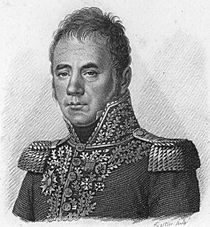Battle of Saguntum facts for kids
Quick facts for kids Battle of Saguntum (1811) |
|||||||
|---|---|---|---|---|---|---|---|
| Part of Peninsular War | |||||||
 Battle of Saguntum |
|||||||
|
|||||||
| Belligerents | |||||||
| Commanders and leaders | |||||||
| Strength | |||||||
| 18,000–20,000 | Blake: 23,000-28,000 Andriani: 2,663-3,000 |
||||||
| Casualties and losses | |||||||
| Battle: 1,000 Siege: 420–1,000 |
Battle: 5,700-6,000 Siege: 2,663-3,000 |
||||||
The Battle of Saguntum happened on October 25, 1811. It was a fight between the French army, led by Marshal Louis Gabriel Suchet, and a Spanish army, led by Captain General Joaquín Blake. This battle was part of the Peninsular War, which was itself part of the bigger Napoleonic Wars.
The Spanish army tried to stop the French from taking Sagunto Castle, but they failed. The French, along with their Italian and Polish allies, completely defeated the Spanish troops. Sagunto is a city on the east coast of Spain, about 30 kilometers (19 miles) north of Valencia.
Marshal Suchet had invaded the province of Valencia in September 1811. He tried to capture Sagunto Castle quickly. However, the castle's defenders, led by Colonel Luis Andriani, fought back hard. They stopped two French attacks, forcing Suchet's army to surround the old fortress instead.
When General Blake's army marched from Valencia to help the castle, Suchet prepared his smaller army to fight them. Blake's attack on the French right side didn't go well. Soon, the Spanish troops, who weren't very well trained, started to run away.
However, the Spanish troops attacking the French left side were much tougher. The fighting there was very intense. In the end, the French and their allies won, making almost the entire Spanish army flee. The soldiers inside Sagunto Castle soon gave up. Blake's remaining soldiers went back to Valencia to try and get the city ready for defense.
Contents
Background to the Battle
Armies Involved
The French Army of Aragon, led by Louis Gabriel Suchet, had won two big battles earlier in 1811. They captured Tortosa in January and Tarragona in June. In Tarragona, the French killed or captured 15,000 Spanish soldiers. This was a huge loss for Spain. Capturing Tarragona made Suchet a marshal, a very high rank.
Emperor Napoleon wanted to take over the Province of Valencia. But first, the French needed to recapture Sant Ferran Castle. This castle was on an important road between France and Spain. The French finally took it back in August 1811.
Just six days later, Napoleon told Suchet to attack Valencia. Napoleon thought the Spanish army in Valencia was scared and that the city would be easy to capture. But he was wrong. Sagunto Castle would hold out for many weeks.
The Spanish Army of Valencia was not known for being a strong fighting force. In October 1811, it had about 36,000 soldiers. Many of these were new recruits with few experienced officers. The best parts of the army were two divisions led by Major Generals Miguel Lardizabal y Uribe and José Pascual de Zayas y Chacón. These soldiers had fought bravely in the Battle of Albuera. When Blake took command, he brought these two divisions with him from Cádiz.
Marshal Suchet's French Army of Aragon had 50,000 soldiers. But many were guarding places or were sick. Only about 31,000 were ready to fight. Suchet chose 22,000 of his best infantry soldiers for the Valencia campaign. He also brought almost all his cavalry and artillery (cannons). The only weak part of his army was 1,500 soldiers from Naples, led by General Claude Antoine Compère.
French Advance to Sagunto
Suchet's army moved in three groups. The main group, with 11,000 soldiers, cannons, and supplies, marched along the coast road from Tortosa. Another group of 7,000 soldiers, mostly Italians, moved through the mountains. The third group, with 5,000 French soldiers, marched from Teruel. This group was in the most danger because it was closest to Blake's Spanish army.
General Blake decided not to fight the French in open battle. Instead, he told his soldiers to build strong defenses around Valencia. About 32 kilometers (20 miles) north of Valencia, at Sagunto, Blake ordered a powerful fortress to be built. This place used to be the Roman city of Saguntum. Its old walls were repaired using stones from ancient ruins, including a Roman theater. But the work was not finished when Suchet's army arrived.
The fortress was defended by 2,663 Spanish soldiers, led by Colonel Andriani. They had 17 cannons, but most were small. The Spanish also had soldiers guarding Peniscola and Oropesa del Mar.
On September 15, all three French groups started moving. They passed Peniscola and Oropesa, leaving some soldiers to watch them. On September 22, Suchet's entire army gathered at Castellón de la Plana. They easily pushed aside 500 Spanish troops at Villarreal. The next day, they reached Sagunto Castle.
Siege of Sagunto Castle
On September 23, the French army surrounded Sagunto Castle. Suchet's cavalry rode south, almost to Valencia, without meeting much resistance. Suchet saw that the castle's defenses were not complete and had two weak spots. He decided to try a surprise attack at midnight on September 27–28.
French soldiers tried to sneak up to the castle, but they were spotted. The Spanish defenders were ready and fought bravely. They knocked down ladders and killed any French soldier who reached the top of the wall. The French kept trying, but the Spanish held their ground. After heavy fighting, the French had to retreat. Suchet admitted losing 247 soldiers, but others said it was closer to 360. The Spanish lost only 15 killed and fewer than 30 wounded.
After this failed attack, Suchet waited for his heavy siege cannons to arrive. These cannons had to blast through two Spanish towers at Oropesa first. While waiting, French engineers started preparing places for the cannons on the hill.
Blake didn't want his soldiers to fight Suchet's experienced army in an open battle. He hoped to make Suchet leave by cutting off his supplies. Spanish guerrilla fighters attacked French supply lines. For example, Juan Martín Díez and his guerrillas captured 560 Italian soldiers at Calatayud on October 3. Another guerrilla leader, Francisco Espoz y Mina, captured 600 Italian soldiers on October 16. But these small victories didn't stop Suchet from continuing the siege of Sagunto.
On October 10, Suchet's siege cannons reached Oropesa. They forced the Spanish soldiers in the first tower to surrender. The next day, the soldiers in the second tower escaped by ship. On October 12, the cannons finally arrived at Sagunto Castle.
It took Suchet's troops four days to drag the heavy cannons up the rocky hill and set them up. They even had to bring earth from the bottom of the hill to build walls for protection. On October 16, the cannons started firing. By the afternoon of October 18, they had made a hole in the Spanish defenses. Suchet ordered another attack for that evening.
Four hundred French soldiers led the attack, supported by Italian troops. The cannons kept firing until the last minute. The Spanish defenders bravely stood at their posts, trying to block the hole with sandbags. At 5:00 pm, the French rushed forward but were stopped by heavy fire. Only a few French soldiers reached the top, but they were killed. The attack failed completely. Suchet said he lost 173 soldiers, but the real number was closer to 300.
After this second failure, Suchet decided to use slower, more traditional siege methods. The Spanish defenders continued to fight fiercely. The French lost 15–20 men every day trying to get closer to the Spanish walls.
Meanwhile, Blake's army was joined by more troops. Blake knew that the people of Valencia wanted him to fight a battle. If he didn't, he might lose his command. So, on October 24, Blake set out with his army to help Sagunto Castle.
The Battle of Saguntum
Blake planned to attack the French army with his right side, while his main force would crush the French right side. His right side had 5,500 experienced soldiers and 3,500 reserve troops. They also had 1,100 cavalry and three cannon batteries. Blake's left side had 10,750 infantry soldiers and 1,700 cavalry. In total, Blake had about 10,500 troops attacking the French left and 17,000 attacking the French right.
Suchet kept about 4,000 soldiers to continue the siege of Sagunto Castle. To face Blake's army, Suchet had 12,000 infantry, 1,800 cavalry, and six cannon batteries. This was about 14,000 men in total. Even though he had fewer soldiers, Suchet knew his army was better trained and more experienced than Blake's.
Suchet placed his soldiers carefully. His left side was on a flat plain. His right side was on the top of the Sancti Espiritus Hills.
Around 7:00 am, the Spanish attack began. On Blake's left, two Spanish divisions moved to attack the French. As they marched up the hills, one Spanish division was ahead of the other. When the Spanish started pushing back the French, General Józef Chłopicki, who was in command of the French right, ordered an attack.
The French and Italian soldiers charged downhill. The Spanish soldiers were surprised and quickly pushed back. Italian cavalry rode into the gap between the two Spanish divisions, attacking one of them from the side. Seeing their friends running away and the cavalry attacking their side, the Spanish soldiers turned and fled.
General O'Donnell, the Spanish commander on this side, ordered his cavalry forward to protect his infantry. But the Italian cavalry charged the Spanish cavalry, who also turned and ran away. They even rode over some of their own infantry, making them run too. Chłopicki then ordered his soldiers to charge, and the Spanish divisions completely broke apart. They ran away in a panic. The Spanish lost about 400 killed and wounded, but the French captured about 2,000 prisoners and some cannons.
While this was happening, the Spanish right side began its attack. On the Spanish right, the division of Zayas fought a fierce gun battle with the French. In the center, both sides tried to take a small hill. The Spanish got there first, setting up 1,500 soldiers and cannons.
The French attacked the hill with four battalions. They fought hard and forced the Spanish to retreat from the hill. The fighting was tough, and the French lost many soldiers.
Then, 1,100 Spanish cavalry charged the French. This surprise attack broke through the French cavalry on the left side. The Spanish cavalry captured three cannons and almost overran a French infantry regiment.
In this dangerous moment, Suchet ordered more Italian soldiers to fill the gap in his line. He then led his own cavalry, 350 cuirassiers (heavily armored cavalry), to charge. The cuirassiers crashed into the Spanish cavalry and scattered them. Both Spanish cavalry generals were badly wounded and captured. The cuirassiers rode over a Spanish cannon battery and only stopped when they reached a stream far behind the Spanish lines.
Following the cuirassiers, the Italian soldiers drove off the remaining Spanish cavalry. Then, they attacked the Spanish infantry from the side. The Spanish soldiers had fought well, but they finally broke under the pressure.
Blake had set up his command post and reserves too far back to help his soldiers during the battle. He gave the first order to attack, and then just let things happen. When his soldiers started to break, Blake finally ordered his right side to retreat quickly.
A Spanish battalion fought bravely in the village of Puzzol, drawing the attention of the French. This allowed the rest of their division to escape. But other Spanish troops were not so lucky. The French cavalry chased the fleeing Spanish for about 7 miles (11 km), capturing many prisoners and cannons.
Outcome of the Battle
Blake's army lost about 1,000 killed and wounded soldiers, mostly from his best divisions. The French captured 4,641 prisoners and 12 cannons. One Spanish regiment lost 17 officers and 521 men out of 800, mostly taken prisoner. The French admitted losing 130 killed and 590 wounded, but their actual losses were probably around 1,000. Total Spanish losses were around 6,000.
The day after the battle, Suchet sent a messenger to Colonel Andriani, asking the Sagunto Castle defenders to surrender. Andriani soon gave up. The soldiers inside the castle had seen their relief army defeated. They had no more will to fight. The French siege trenches were very close to the Spanish defenses, and one part of the wall was in ruins. The castle would have fallen in the next attack.
The 2,500 Spanish survivors became French prisoners. Most of their cannons were destroyed, and they were low on ammunition.
Suchet could have marched straight to Valencia and attacked Blake's remaining 22,000 demoralized soldiers. But he paused after his victory. After leaving soldiers to guard Sagunto Castle and sending a group to escort the Spanish prisoners, he only had 15,000 men left for fighting. Suchet wanted more soldiers before attacking Valencia. He had to wait for Napoleon's permission, which arrived in December.
See also
 In Spanish: Batalla de Sagunto para niños
In Spanish: Batalla de Sagunto para niños









